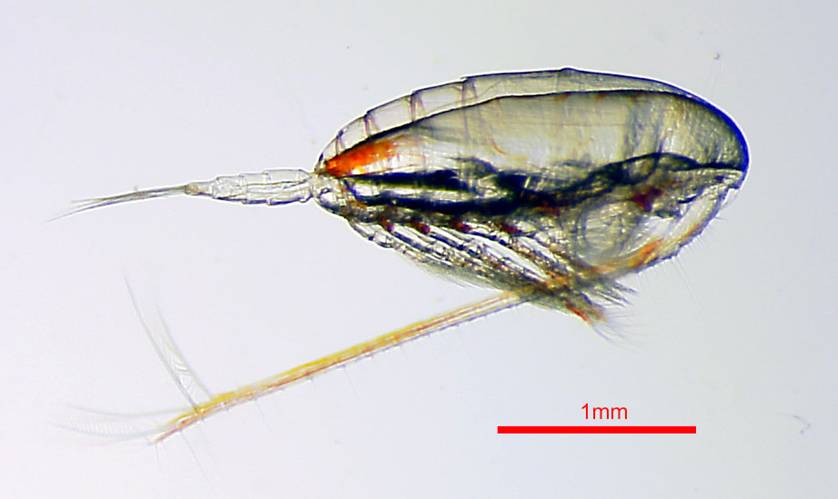Description
The project addresses potential effects of produced water on
the copepod Calanus finmarchicus, which has a key
role in transferring energy from primary production to
higher trophic levels in the North Atlantic and Barents
Sea. Based on dynamic energy budget (DEB) theory, a
modified DEB model for C. finmarchicus will be
developed. Data on uptake and elimination of selected
produced-water components and molecular changes in the
copepods will be used to make a toxicokinetic model that
will be linked to the DEB model. The aim of the work is to
provide effect limits for potential long-term population
effects of produced water that can be used in risk and
impact modelling, and relate these data to molecular changes
that can be used in environmental monitoring. The outcome of
the project will thus benefit both the management and the
industry in securing that the risk of environmental impacts
from offshore petroleum activities are kept to a minimum.
My role
Developing a DEBkiss
model for copepods, in particular Calanus
finmarchicus. Advising on the most efficient
experimental design, and analysing the results from the
experimental testing on toxic effects and toxicokinetics.
|

The calanoid copepod Calanus finmarchicus.
|
|
|
Output: Publications (as first or co-author)
- Jager T, Salaberria I and Hansen BH (2015). Capturing
the life history of the marine copepod Calanus
sinicus into a generic bioenergetics framework.
Ecological Modelling 299:114-120. DOI
10.1016/j.ecolmodel.2014.12.011
- Hansen BH, Jager T, Altin D, Øverjordet IB, Olsen AJ,
Salaberria I and Nordtug T (2016). Acute toxicity of
dispersed crude oil on the cold-water copepod Calanus
finmarchicus: elusive implications of lipid
content. J. Toxicol. Environ. Health. 79(13-15):549-557.
http://dx.doi.org/10.1080/15287394.2016.1171981
- Jager T (2016). Predicting environmental risk: a road
map for the future. J. Toxicol. Environ. Health.
79(13-15):572-584. http://dx.doi.org/10.1080/15287394.2016.1171986
- Jager T, Altin D, Miljeteig C and Hansen BH (2016).
Stage- and sex-dependent sensitivity to water soluble
fractions of fresh and weathered oil in the marine
copepod Calanus finmarchicus. Environ Toxicol
Chem 35(3):728-735. DOI
10.1002/etc.3237
- Jager T, Salaberria I, Altin D, Nordtug T and Hansen
BH (2017). Modelling the dynamics of growth, development
and lipid storage in the marine copepod Calanus
finmarchicus. Marine Biology 164:1. DOI
10.1007/s00227-016-3030-8 (Open Access)
- Jager T, Øverjordet IB, Nepstad R and Hansen BH
(2017). Dynamic links between lipid storage,
toxicokinetics and mortality in a marine copepod exposed
to dimethylnaphthalene. Environ. Sci. Technol. 51(13):7707-7713.
DOI
10.1021/acs.est.7b02212 (support package for BYOM,
see BYOM
page).
Related publications with SINTEF (as first or co-author)
- Hansen BH, Altin D, Øverjordet IB, Jager T and Nordtug
T (2013). Acute exposure of water soluble fractions of
marine diesel on Arctic Calanus glacialis and
boreal Calanus finmarchicus: Effects on survival
and biomarker response. Sci Tot Environ 449:276–284. DOI
10.1016/j.scitotenv.2013.01.020
- Jager T and Hansen BH (2013). Linking survival and
biomarker responses over time. Environ Toxicol Chem
32(8):1842-1845 DOI
10.1002/etc.2258
Output: Presentations (as presenter and as contributor)
- Bioavailability and toxicity of polycyclic aromatic
hydrocarbons in the copepod Calanus finmarchicus.
Presented by Bjørn Henrik Hansen at the 5th
NETS conference in Stavanger, Norway. 23-24
October, 2014 (oral presentation).
- Assessing ecotoxicological effects on a mechanistic
basis: the central role of the individual. Keynote
presented by Tjalling Jager at the 5th
NETS conference in Stavanger, Norway. 23-24
October, 2014 (oral presentation). Download slides as PDF.
- The eccentric life history of marine copepods.
Presented at the 4th
international DEB symposium in Marseille, France.
28-30 April, 2015 (oral presentation). Download
slides as PDF.
- Dynamics of acute oil toxicity in different life
stages of the copepod Calanus finmarchicus.
Presented at the 18th
international symposium on Pollutant Responses in
Marine Organisms (PRIMO), Trondheim, Norway, 24-27
May, 2015 (oral presentation). Download slides
as PDF.
- Baseline energy-budget model for the marine copepod Calanus
finmarchicus. Poster presented at the 26th
SETAC Europe conference in Nantes, France. 22-26
May, 2016. Abstract.
Handout.
- Using GUTS to explain dynamic mortality patterns for a
marine copepod exposed to dimethylnaphthalene. Poster
presented at the 27th
SETAC Europe conference in Brussel, Belgium. 7-11
May 2017. Abstract.
Handout.
- Dynamics of lipid storage in marine copepods and its
consequences for effects of oil pollution. Presented at
the 5th
international DEB symposium in Tromsø, Norway. 31
May-2 June, 2017 (oral presentation). Abstract, slides as PDF.
Final report of the project is available from ResearchGate.
|


